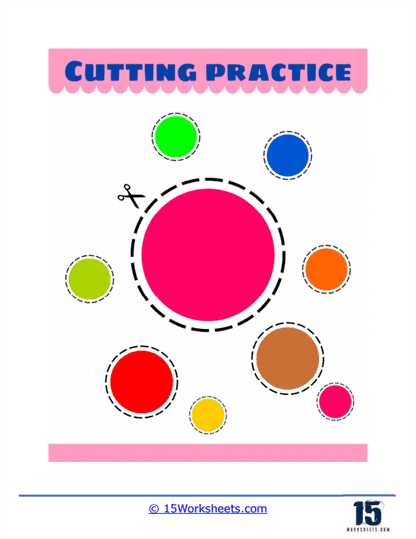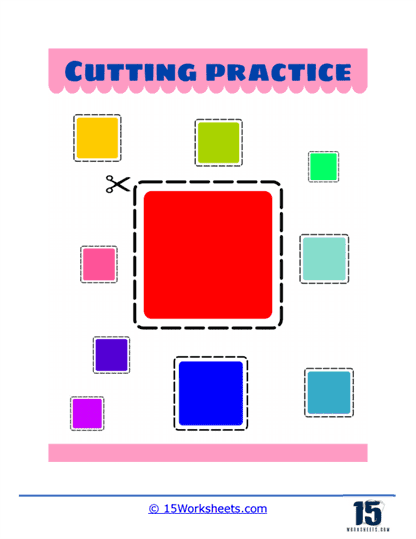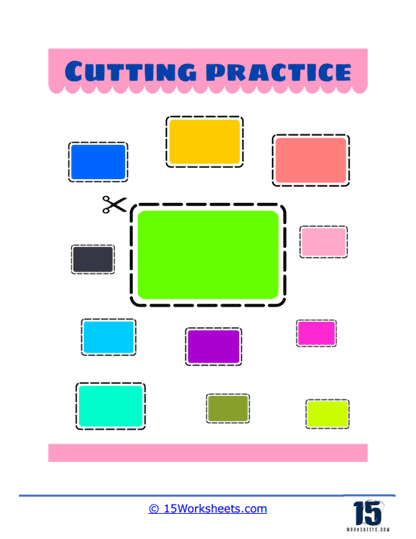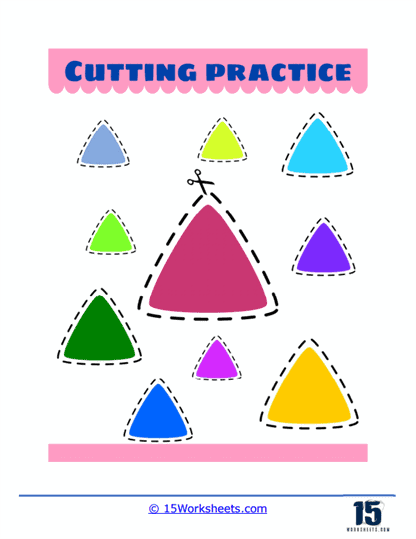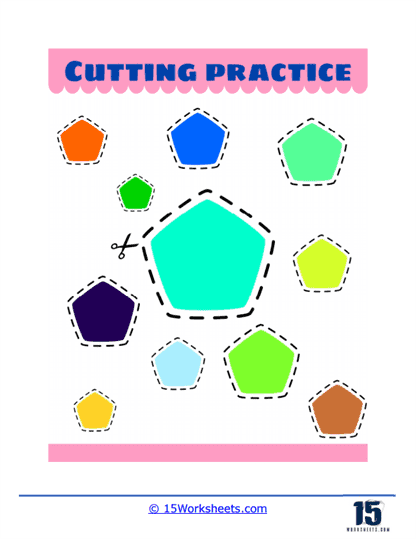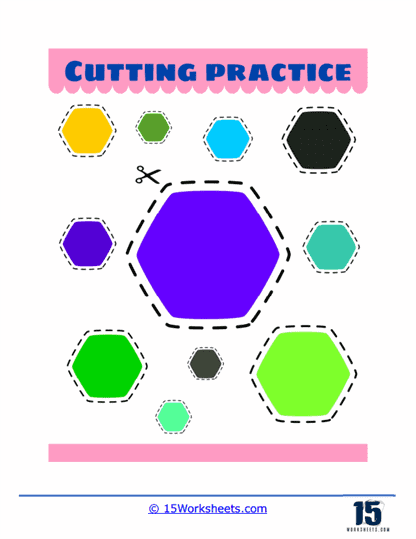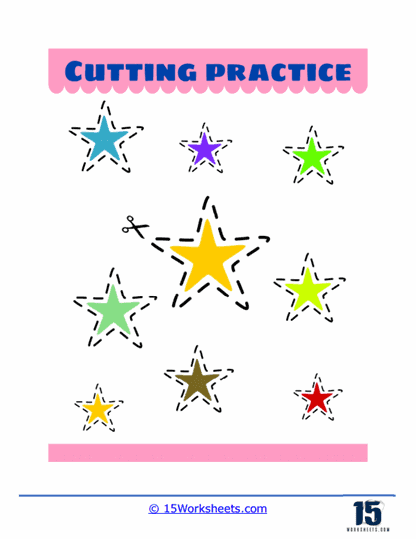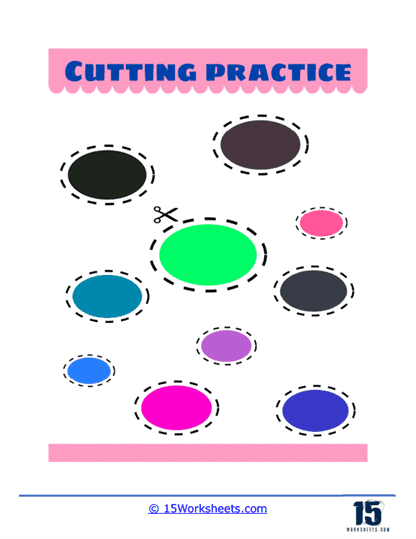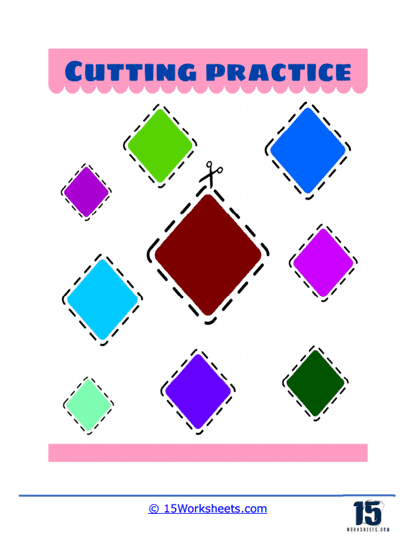Cutting Practice Worksheets
About These 15 Worksheets
These worksheets are specifically designed to help children develop their fine motor skills, particularly those related to using scissors. They are usually targeted at preschoolers and kindergarteners who are just beginning to learn how to hold and use scissors properly.
These worksheets often feature a variety of lines, shapes, or patterns that children are instructed to cut along or out. These can range from simple straight lines to more complex zigzag, curved, or spiral lines. In more advanced worksheets, children might be asked to cut out complex shapes or pictures.
By using these worksheets, children can practice manipulating scissors in different ways, improving their dexterity, hand-eye coordination, and control over the tool. This is important as it aids in their ability to perform various tasks such as writing, drawing, and crafts.
Safety is paramount when children are learning to use scissors, so adult supervision is essential when using cutting practice worksheets. Child-friendly scissors, which have blunt tips and are designed for small hands, should always be used.
A Look at the Individual Worksheets
Ah, the noble art of cutting! For many adults, it’s a mindless chore – snipping coupons, opening Amazon boxes, liberating snacks from their plastic prisons. But for preschoolers? It’s an existential journey of transformation, powered by tiny fingers and a pair of safety scissors. The Cutting Practice with Scissors Worksheets is not just a collection of activities; it’s a rite of passage. In the “Circles,” “Squares,” “Rectangles,” and “Triangles” sheets, children face geometry not with calculators but with courage. Each shape is a battleground. “Why must I cut the square?” asks the young philosopher. “Because,” replies the worksheet in silence, “the square is within you.” This is Euclid, but with glitter and Elmer’s glue.
Then we progress to the spicy side of polygons – “Pentagons” and “Hexagons.” These are the worksheets that whisper to kids, “You thought you understood corners? Think again.” The five and six sides of these shapes seem innocent enough, until you try to cut them and realize that the pointy corners are as slippery as a greased watermelon. Children here learn patience, precision, and, occasionally, the sharp sting of failure (followed by the reassuring hug of a teacher who pretends that crooked sides are just “extra creative”).
And just when you think you’ve mastered shapes, along come the oddballs: “Stars,” “Ovals,” and the ever-enigmatic “Rhombus.” Stars aren’t shapes – they’re cosmic puzzles. One wrong snip and suddenly you’re staring at a mutant octopus. Ovals? They’re circles that have let themselves go, squishing around the page like overripe grapes. And the rhombus… ah, the rhombus. It sits there like a parallelogram that drank too much coffee. Children gaze at it with confusion, then determination. Somewhere between snipping diagonals and questioning their life choices, they grow.
But wait – shapes are only the beginning. “Colorful Shapes” dare to seduce with bright hues, giving students a glimpse of a world where art and math collide. Then “Straight Lines” arrive, looking easy but concealing a secret challenge: staying straight is hard. These lines test your resolve. Wobble, and the paper judges you. “Wavy Lines” are their cooler cousin, encouraging kids to embrace the ups and downs. It’s basically emotional therapy in squiggle form. “Spiral Pattern” goes full chaos theory, leading tiny hands down a whirlpool of scissors-induced dizziness. If you can cut a spiral, you can handle a midlife crisis.
Finally, we reach the grand masters of scissor dojo: “Cut Along” and “A Zigzag Path.” These worksheets are less about cutting and more about surviving. “Cut Along” teaches you the beauty of boundaries – and how quickly you can cross them. “A Zigzag Path” is the final boss battle: a jagged journey through peaks and valleys, highs and lows, existential dread and triumphant snipping. By the end, children are not just better cutters – they are warriors of the craft. These worksheets don’t just teach cutting. They forge character, one squiggly line at a time.
Teaching Kids How to Use Scissors
Teaching kids to use scissors is an important skill that helps them develop fine motor skills, hand-eye coordination, and independence. Here are some steps and tips to teach kids to use scissors:
Choose the Right Scissors
Start with child-friendly scissors that have a comfortable grip, blunt tips, and are the appropriate size for the child’s hands. Scissors with spring action can also be helpful for beginners, as they automatically open after each cut, making it easier for the child to learn.
Teach Proper Grip
Show the child how to hold the scissors correctly. The thumb should go into the smaller hole, while the middle and ring fingers go into the larger hole, and the index finger rests on the outside of the larger hole for support.
Demonstrate Cutting Technique
Demonstrate the correct cutting technique by opening and closing the scissors while moving them forward. Explain that the child should keep their thumb facing up, and emphasize the importance of cutting away from their body for safety.
Start With Simple Cutting Activities
Begin by having the child practice cutting straight lines, curved lines, and basic shapes on strips of paper or worksheets specifically designed for scissor practice. You can also use playdough or modeling clay for initial practice, as it requires less precision.
Gradually Increase Difficulty
As the child becomes more comfortable with using scissors, introduce more complex shapes and patterns to cut. Encourage them to cut out pictures from magazines or old greeting cards, or provide templates for them to follow.
Use Verbal Cues
Use simple verbal cues to guide the child through the cutting process, such as “open,” “close,” “cut,” and “stop.” This will help them understand the sequence of actions required for successful cutting.
Supervise and Support
Always supervise children when they’re using scissors, and provide guidance and support as needed. Offer praise and encouragement for their efforts, and remind them that practice will help them improve their skills.
Incorporate Cutting into Creative Activities
Engage children in arts and crafts projects that require cutting, such as making collages, constructing paper animals, or creating greeting cards. This will help them practice their scissor skills while also encouraging creativity and self-expression.
Be Patient and Consistent
Learning to use scissors is a gradual process that requires practice and patience. Be supportive and encourage children to keep trying, even if they find it challenging at first.
By following these steps and tips, you can help children develop their scissor skills in a safe, supportive, and engaging environment. Remember that each child develops at their own pace, so be patient and provide plenty of opportunities for practice and growth.

